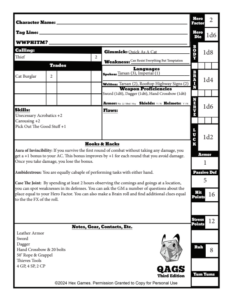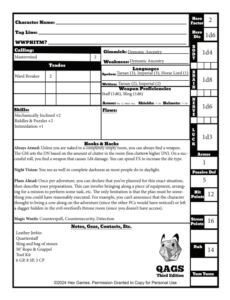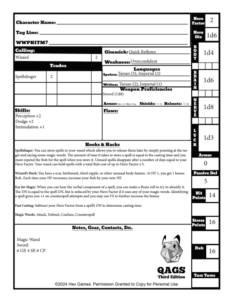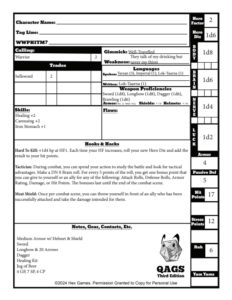We may earn money or products from the companies mentioned in this post.
After th e initial release of QAGS, it didn’t take us very long to realize that the wonky system wasn’t really geared for easy modification. For QAGS 3E, I’m trying to correct that mistake because, at least for me, the level of rules complexity I want varies from one game to another. Maybe it’s because I grew up playing D&D, but when it comes to fantasy games in particular I tend to want more crunch than I do in most other games.
e initial release of QAGS, it didn’t take us very long to realize that the wonky system wasn’t really geared for easy modification. For QAGS 3E, I’m trying to correct that mistake because, at least for me, the level of rules complexity I want varies from one game to another. Maybe it’s because I grew up playing D&D, but when it comes to fantasy games in particular I tend to want more crunch than I do in most other games.
Since I’m hoping to start a regular game set in the City of Ten Thousand Daggers soon, I’ve been thinking about what kinds of rules I’ll need to adapt the new QAGS rules to that world. This led me to something that I used to think was overly-restrictive and unnecessary: a character class system.
Back when we wrote QAGS, I though of character classes as something that limited characters to cookie-cutter stereotypes. While I still see the merits of that argument, 25 years of running a game with an a la carte ability system has shown me one major benefit of character classes: they result in characters that make sense. With classless systems, that’s far from guaranteed, often leading to characters who are just a mess of mismatched kewl skillz and abilities.
 One big reason that I find character classes handy in fantasy games is that they help identify who can do what, particularly when magic and other supernatural powers are involved. Without character classes, it’s harder to keep the right kind of powers with the right kind of characters. Among other potential problems, this can lead to a Dangerous Journeys style situation where even the most meat-headed fighter knows half a dozen spells. The other option is to force players to waste character points or Gimmicks on some kind of “Force sensitivity” type ability that lets them cast spells.
One big reason that I find character classes handy in fantasy games is that they help identify who can do what, particularly when magic and other supernatural powers are involved. Without character classes, it’s harder to keep the right kind of powers with the right kind of characters. Among other potential problems, this can lead to a Dangerous Journeys style situation where even the most meat-headed fighter knows half a dozen spells. The other option is to force players to waste character points or Gimmicks on some kind of “Force sensitivity” type ability that lets them cast spells.
Another thing that’s made me more open to the idea of character classes is watching the show Leverage. If you replace “Hacker” with “Specialist”, their “Mastermind, Grifter, Hitter, Thief, Hacker” is a character class system that works for most action games. It’s such a good taxonomy, I stole it for C10KD. The leverage “character classes” are the inspiration for the five standard Callings that I’m using for the City of Ten Thousand Daggers:
- Hucksters are characters who rely on their ability to influence and manipulate other people: grifters, merchants, diplomats, fixers, bards, gamblers, etc. They’re basically grifters, but I wanted a name that was at least slightly less loaded with criminal intent.
- Masterminds can obviously work well for the various scholars, scientists, and geniuses that populate stories, but it also works for criminal masterminds, con artists, information brokers, and many other types that aren’t necessarily highly educated elites.
- Thieves are pretty much your standard universe of D&D thieves, but without the assumption that snake-oil salesmen are experts at disabling traps. The basic divide is that Hucksters rely on charisma, Thieves rely on skill.
- Warriors are self explanatory and include the standard mix of swashbucklers, sharpshooters, and meat shields.
- Wizards have, obviously enough, dedicated their lives to learning the magical arts. They’re not the only Calling that can use spells, but they’re way better at it.
 The Callings are pretty basic. They’ll set guidelines for what weapons and armor the character can use by default, languages, spell points, hit points, etc. Some (like Wizard) may have additional rules as needed. Other than the basics, your Calling gives you a number of special abilities equal to your Hero Factor. More on those later.
The Callings are pretty basic. They’ll set guidelines for what weapons and armor the character can use by default, languages, spell points, hit points, etc. Some (like Wizard) may have additional rules as needed. Other than the basics, your Calling gives you a number of special abilities equal to your Hero Factor. More on those later.
The images in this article are screen caps of some pre-gens I made for a City of Ten Thousand Daggers one-shot that unfortunately got started (barely) but not completed. Hopefully they’ll help clarify things. The special abilities I mentioned above are in the “Hooks & Hacks” section of the character sheet (though a few have other stuff there as well). Patreon members can download a PDF with all 15 character sheets–just go to the Patreon post for this article.
Trades are kind of like, but not quite, subclasses. They allow you to use your level in the Trade just like you would your Calling bonus. So if you’re a Hero Factor 3 Warrior with 2 levels in Bounty Hunter, you’d add +2 to rolls for bounty hunter-specific rolls (tracking, for example), but use your +3 Calling bonus for combat and skills that are common to nearly all warriors.
I think I’ve mentioned before that you add 0.1 to your Hero Factor after each successful adventure and your Hero Factor increase when it rolls over to the next whole number. Trades will work similarly, though I haven’t decided if each successful adventure lets you add 0.1 to a single Trade or if you just increase your level in a trade of your choice each time your HF goes up. When you get a level in a Trade, you can use it for any Trade that you meet the requirements for.
 At first level, a trade just gives you the core abilities and trappings of the Trade. Starting at level 2, you get a special ability at each level just like the ones you get for your Calling. Unlike callings, you don’t have to pick your Trades from a list. You can have any Trade that the GM and other players agree makes sense. While some Trades are best for (and may even require) a particular calling, for the most part you can pick any Trade regardless of calling. For example, one gang enforcer might be a Thief with the Thug or Bravo trade, another could be a Fighter with a Trade of Mugger or Gangster.
At first level, a trade just gives you the core abilities and trappings of the Trade. Starting at level 2, you get a special ability at each level just like the ones you get for your Calling. Unlike callings, you don’t have to pick your Trades from a list. You can have any Trade that the GM and other players agree makes sense. While some Trades are best for (and may even require) a particular calling, for the most part you can pick any Trade regardless of calling. For example, one gang enforcer might be a Thief with the Thug or Bravo trade, another could be a Fighter with a Trade of Mugger or Gangster.
The Calling and Trade set-up, where Calling is what you’re good at and Trade is what you’re doing right now, actually fits pretty well with the kind of pulpy fantasy stories that I like. Conan and Fafhrd are both Warriors by Calling, but their current Trade may be barbarian, thief, pirate, king, or mercenary depending on the story. Going back to Leverage, it also works in the other direction. The Leverage crew has characters from all five Callings, but they all have at least a few levels in the Con Artist Trade (and Elliot has at least a level in Chef).
Like the trades, the special abilities that you get each time your Hero Factor or level goes up are open-ended, but I plan to include a lot of common examples to give players and GMs a baseline. Some special abilities may have multiple power levels so that if you get multiple levels in a trade you have the option of increasing your power level for a specific ability instead of learning a new one. Where possible, I’m trying to focus on “story” type rules here (ask the GM a question, call upon a resource or ally, etc.) to make them feel like more than just another bonus.
 The Callings and Trades set-up isn’t necessary for every game, but there are two kinds of games where I think they’ll come in handy. The first, obviously, is something like fantasy where you need some kind of way of deciding who can use what abilities. The other is for something like a war game or a spy game (or M-Force) where all characters basically have the same job. In this case, you use the Leverage trick of making the common training a Trade that everyone has at least one level in. Since the idea has only seen about an hour’s worth playtesting, I still need to see how it works at the table, but it feels like a good idea.
The Callings and Trades set-up isn’t necessary for every game, but there are two kinds of games where I think they’ll come in handy. The first, obviously, is something like fantasy where you need some kind of way of deciding who can use what abilities. The other is for something like a war game or a spy game (or M-Force) where all characters basically have the same job. In this case, you use the Leverage trick of making the common training a Trade that everyone has at least one level in. Since the idea has only seen about an hour’s worth playtesting, I still need to see how it works at the table, but it feels like a good idea.





